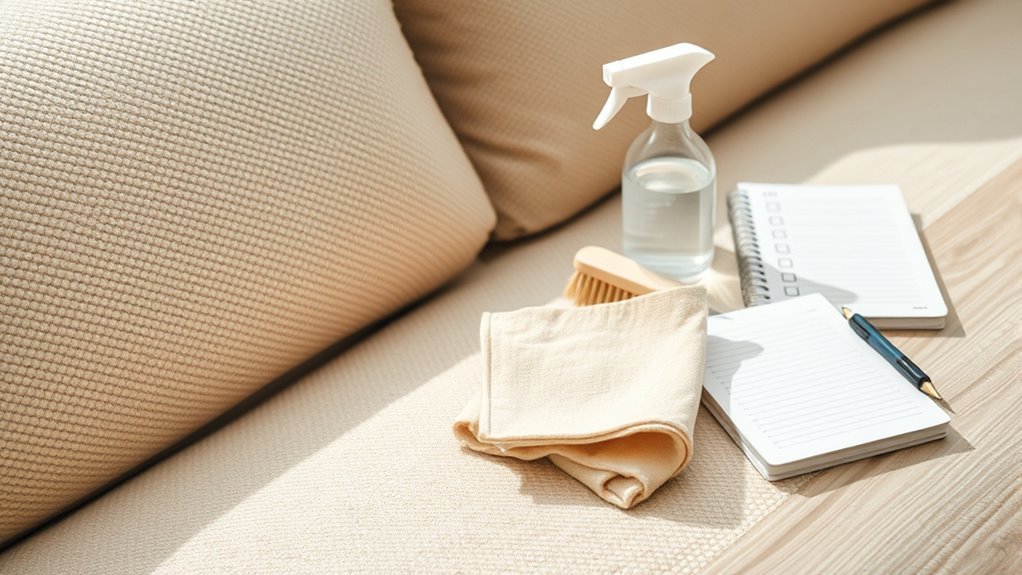Deep Cleaning Checklist for Couch
To deep clean your couch, start by checking the fabric type and care tags to avoid damage. Vacuum thoroughly using upholstery and crevice tools to remove loose dirt. Treat stains promptly with gentle cleaners, testing in hidden spots first. Remove cushion covers and wash as directed, then dry properly. Don’t forget to clean the frame and base, and freshen with mild deodorizer. Following these steps guarantees a fresh, well-maintained couch—keep going to uncover more helpful tips for long-lasting care.
Assessing the Couch Material and Cleaning Requirements

Before you start deep cleaning your couch, it’s important to identify the material it’s made from and understand its specific cleaning needs. Different fabric types require different care instructions, so knowing what you’re dealing with saves you from costly mistakes. For example, natural fibers like cotton or linen are durable but may shrink if cleaned improperly, while delicate fabrics like silk or velvet need gentle handling. Synthetic options like polyester are generally easier to clean but can react differently to harsh chemicals. Check the manufacturer’s tag for cleaning codes—these give you clues on which methods and products are safe. Taking the time to assess your couch’s fabric types and following the recommended care instructions guarantees you can clean effectively without risking damage, giving you freedom to enjoy a fresh, well-maintained couch.
Removing Loose Dirt and Debris
Before you start deep cleaning, it’s important to remove any loose dirt and debris from your couch. You’ll want to use the right vacuuming techniques to reach every nook and cranny. Also, knowing quick spot removal tips can help tackle stains before they set in.
Vacuuming Techniques
To effectively remove loose dirt and debris from your couch, start by using the right vacuum attachments, such as the upholstery brush or crevice tool. These tools help you reach every nook and cranny without damaging your fabric. Keeping a consistent vacuuming frequency is key to maintaining a fresh couch and preventing buildup.
Here’s how to make the most of your vacuuming routine:
- Use the upholstery brush for fabric surfaces to lift dirt gently.
- Switch to the crevice tool for tight spaces and seams.
- Vacuum in multiple directions to catch hidden debris.
- Empty the vacuum canister regularly to maintain suction power.
Spot Removal Tips
A quick spot removal can make a big difference in keeping your couch looking clean between deep cleans. When you notice loose dirt or debris, start with gentle spot cleaning techniques like blotting with a damp cloth or using a soft brush to lift particles without grinding them in. Avoid harsh scrubbing; this protects your upholstery care routine by preserving fabric integrity. You can also use a mild detergent diluted in water for stubborn spots, but always test in an inconspicuous area first. Removing debris promptly prevents stains from setting and keeps your couch fresh, giving you the freedom to relax without worry. Regularly addressing spots as they appear simplifies deep cleaning later and maintains your couch’s vibrant look effortlessly.
Cleaning Couch Cushions and Covers

When tackling stains on your couch cushions, it’s important to act quickly and use the right cleaning products. You’ll also want to follow specific washing and drying instructions to avoid damage or shrinkage. Let’s go over some effective stain removal methods and care tips for your cushion covers.
Removing Stains Effectively
Although stains on couch cushions and covers can seem stubborn, you can tackle them effectively with the right approach. For successful stain removal, choose cleaning solutions suited to your fabric type and act quickly. Start by blotting spills gently—rubbing can spread the stain or damage fibers. Then, try these steps:
- Test cleaning solutions on a hidden area first to avoid discoloration.
- Use a mix of mild detergent and water for general stains.
- For tougher spots, consider vinegar or baking soda-based cleaners.
- Always blot with a clean cloth and avoid soaking the fabric.
Washing and Drying Tips
Once you’ve tackled stains on your couch cushions and covers, the next step is knowing how to wash and dry them properly to keep the fabric in great shape. Choosing the right washing methods and drying techniques can free you from damage worries and keep your couch fresh. Always check care labels first—some covers need gentle cycles or hand washing, while others can handle machine washing.
| Washing Methods | Drying Techniques |
|---|---|
| Machine wash cold | Air dry flat |
| Hand wash with mild soap | Tumble dry low heat |
| Spot clean for delicate fabrics | Avoid direct sunlight |
| Use gentle detergent | Use drying rack |
| Avoid bleach | Fluff cushions after drying |
Follow these tips, and your cushions will stay comfy and looking great!
Treating Stains and Spots Effectively
If you want to keep your couch looking fresh, addressing stains and spots as soon as they appear is crucial. Prompt stain removal prevents permanent damage and keeps your furniture inviting. For effective spot treatment, act quickly and choose the right method.
Here’s how to tackle stains with freedom and ease:
- Blot spills immediately with a clean cloth to avoid spreading.
- Use a gentle fabric cleaner or a homemade solution (like vinegar and water) for spot treatment.
- Test any cleaner on a hidden area first to verify no discoloration.
- Avoid rubbing; instead, dab gently to lift the stain without damaging fibers.
Deep Cleaning the Couch Frame and Base

After tackling stains and spots, it’s important not to overlook the couch frame and base, which can collect dust, dirt, and allergens over time. For effective frame care, start by vacuuming these areas with a brush attachment to loosen debris. If your frame is wooden, wipe it down with a damp cloth and mild soap to remove grime without damaging the finish. When focusing on base cleaning, check for loose screws or any damage that needs fixing—this keeps your couch sturdy and safe. Use a soft brush or microfiber cloth to clean hard-to-reach spots. Regular attention to the frame and base not only extends your couch’s life but also keeps your living space fresh and inviting, giving you the freedom to relax without worry.
Deodorizing and Refreshing the Couch
Though regular cleaning removes dirt and stains, your couch can still hold onto odors that make your living space less inviting. To truly refresh and deodorize your couch, you want to break free from stale smells and enjoy a fresh environment. Here’s how to do it effectively:
- Use couch fresheners designed to neutralize odors without masking them.
- Apply fabric sprays evenly, focusing on areas prone to sweat or pet scents.
- Let the couch air out by opening windows or using fans to circulate fresh air.
- Sprinkle baking soda on cushions, let it sit for 15-20 minutes, then vacuum to absorb lingering smells.
Final Inspection and Maintenance Tips
Once you’ve finished deep cleaning and deodorizing your couch, it’s important to conduct a final inspection to guarantee every spot is spotless and no residue remains. Take a close look at cushions, seams, and hidden corners during your couch inspection to catch any overlooked dirt or stains. Make sure the fabric feels dry and fresh before moving on. To keep that freedom-fueled freshness going, establish a maintenance routine that fits your lifestyle. Vacuum regularly, address spills immediately, and rotate cushions to prevent uneven wear. This routine not only preserves your couch’s appearance but also extends its life, giving you more time to relax without worry. With these simple steps, you’re setting yourself free from constant deep cleaning headaches.
Frequently Asked Questions
How Often Should I Deep Clean My Couch?
You should deep clean your couch every 6 to 12 months, depending on use and exposure to dirt or pets. Following cleaning frequency guidelines helps keep your furniture fresh and extends its life. Incorporate regular couch maintenance tips like vacuuming and spot cleaning to reduce buildup between deep cleans. Sticking to this routine lets you enjoy a clean, comfy space without feeling chained to constant chores.
Can I Use a Steam Cleaner on All Couch Types?
You might worry a steam cleaner could damage your couch, but it’s all about steam cleaner compatibility and couch material considerations. Most fabric couches handle steam well, but delicate materials like silk or leather can suffer. To keep your freedom intact and avoid mishaps, always check the manufacturer’s label first. If you’re unsure, spot test a hidden area or opt for a gentler cleaning method instead of risking damage.
What Are the Best Natural Cleaning Products for Couches?
When it comes to couch cleaning with natural solutions, you’ll love using white vinegar, baking soda, and mild castile soap. These ingredients are gentle yet effective, giving you the freedom to clean without harsh chemicals. Mix vinegar and water for a revitalizing spray, sprinkle baking soda to deodorize, and use castile soap for spot cleaning. These natural options make it easy for you to keep your couch fresh and healthy, naturally.
How Do I Prevent Pet Hair From Sticking to the Couch?
To keep pet hair off your couch, you’ll want to stay on top of pet grooming—regular brushing reduces shedding a ton. Using couch covers is a total game-changer too; they protect your furniture and are way easier to clean. You’ll enjoy more freedom knowing your space stays fresh without constant vacuuming. Plus, covers come off and go in the wash, so you can relax and let your pets hang out without worry.
Is Professional Couch Cleaning Worth the Cost?
When you weigh the cost benefits, professional couch cleaning can be worth it if you want to save time and get deep results. Compared to DIY methods, services use specialized tools and solutions that can extend your couch’s life and improve its look. If you value freedom from hassle and want a thorough job without the effort, investing in a professional service might be the best choice for you.






